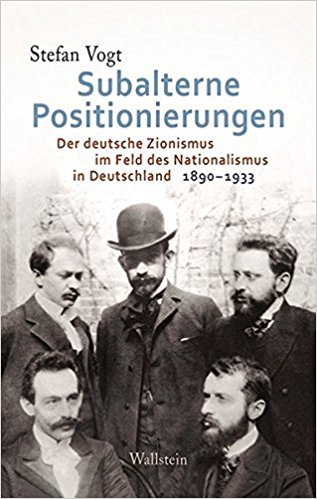
In 1931, the German Zionist publicist Robert Weltsch described the ambivalent relationship between German Zionism and German nationalism. Considering interwar realities, Zionism needed to distance itself from the growing intolerance, self-aggrandizement, and anti-Jewish character of modern nationalist movements, but it could also not be denied that Zionism and nationalism shared similar roots: both rejected liberalism and believed in the virtue of a creative national community. With his comprehensive study of German Zionism from the fin-de-siècle until the advent of the National Socialist era in 1933, Vogt offers a dense but legible overview of the main actors, ideas, and activities of the movement during the late German Imperial period until the end of the Weimar years. Vogt’s main scholarly intervention is his claim that German Zionism should be understood in relation to German nationalist thought, not only in theoretical terms, but also by exploring how German Zionists positioned themselves within larger contemporary nationalist debates. At the same time, Vogt argues, it is equally important to study the way German nationalist thinkers and politicians, most notably those with openly anti-Semitic ideas, regarded and engaged with Zionism. Rather than offering a summary of the history of German Zionism, Vogt focuses on six political-ideological constellations: the Zionist debates about völkisch nationalism and “civilization” at the end of the nineteenth century, the Zionists’ engagement with racial discourses and German colonialism, their position regarding the First World War, debates about the relationship between nationalism and socialism, the connection between Zionism and the German youth movement and the Weimarian conservative revolution, and, lastly, the Zionist dealing with antisemitism and the rise of National Socialism.
As a result, the image arises of a neo-romantic, Fichte-inspired type of nationalism, which simultaneously propagated moderately national politics that were atypical for a “völkisch” national movement. According to Vogt, the growing anti-Semitic climate in which the German Zionists were active, and their often surprisingly respectful engagement with representatives of the increasingly illiberal German nationalist movements, nonetheless compelled the Zionists to formulate a version of their own nationalism that would not repeat the faults of German nationalism. By contrast, the German Zionists held on to a humanistic and emancipatory version of nationalism that valued a Jewish cultural renaissance over territory and statism, with a strong focus on universalist ideals. This viewpoint developed into a völkisch nationalism that was free from the chauvinism of German nationalism. Eventually, their approach would turn the German Zionists into supporters of more liberal policies regarding the Palestinian Arabs, and to become the central proponents of a bi-national state in Palestine. In this light, it was no coincidence that the bi-nationalist Zionist movement Brit Shalom consisted for a large part of these very same German Zionists, the most famous of whom were philosopher Martin Buber, historian and later scholar of nationalism Hans Kohn, and Robert Weltsch, the editor-in-chief of the most important German Zionist periodical, the Jüdische Rundschau. The work and thought of these and other central German Zionists feature extensively in Vogt’s exploration of the ideological and intellectual underpinnings of the movement.
Vogt also compellingly demonstrates how one way of positioning German Zionism is to reveal the ambivalent but undeniably close relationship between the Zionists and German colonialism. By pointing at such a connection, Vogt joins an ever-growing list of scholars who have sought to explain Zionism—and other forms of Jewish territorial politics—in the context of colonial and imperial history. Nevertheless, Vogt is indeed correct in pointing out that most of these studies focus exclusively on the colonial dimension of the Zionist project in Palestine, while failing to pay attention to Zionism in its original, European context. Here, Vogt introduces his second and most innovative intervention, namely his proposition to understand German Zionism as a form of “subaltern” politics. Originally a term developed within the field of postcolonial studies, Vogt posits that the subaltern framework is a crucial tool to help make sense of the seeming contradictions in German Zionism. Based on the work of postcolonial scholars like Stuart Hall, Partha Chatterjee and Homi Bhabha, the subaltern lens reveals a historical landscape in which formerly colonized peoples adopt many of the ideas and behaviors of their erstwhile colonizers. In effect, these subalterns waver between hegemonic and dominated positions. This “in-betweenness” (Bhabha) complicates a one-dimensional interpretation of subaltern groups, but, as Vogt ardently shows, also serves to disentangle their dual political identities. If we consider the German Zionists as subalterns we can make some sense of their active combatting of antisemitism in Germany, while also supporting German colonial aspirations and the German war effort between 1914 and 1918, as well as the fact that they enthusiastically engaged in debates over race and racialism. Moreover, as subalterns, the Zionists could strive for political and territorial independence in Palestine and at the same time invest, at least ideologically, in peaceful cohabitation with the Palestinian Arabs.
Vogt consistently shows where and how he sees the subaltern dimension appear in the history of German Zionism. The racialist thinking of famous Zionist sociologist Arthur Ruppin and of anthropologist Ignaz Zollschan, for instance, is reassessed as an attempt to reshape the dominant racial theories from a subaltern perspective. In a similar vein, Martin Buber’s and Hans Kohn’s orientalist tendencies are to be understood as an expression of a subaltern understanding of Jewish reality: German Jews could serve as a connecter between German imperial rule and the (potential) colony. Even if at times the subaltern angle seems overly stressed and somewhat far-fetched—for instance in Vogt’s description of the Zionist battles against German antisemitism as a form of postcolonial “identity politics”—thereby also risking unnecessary repetition and an idealization of liberal German Zionist attitudes towards colonial indigenes, the subaltern approach does prove an illuminating narrative thread. By terming the Zionists subalterns that were active between ostensibly opposite worlds, Vogt clarifies how in the Zionist imagination a reliance on nationalism could turn into an emancipatory strategy for Jews themselves, but also for the Arab population in Palestine. Moreover, by including the subaltern category, Vogt forges novel connections with other bodies of scholarship, thus latching onto the most recent trends in “post-post-Zionist” historiography.
As for the German-Zionist connection, by describing the different ways in which Zionists communicated with German nationalists and anti-Semites, the Zionist movement is situated within the specifically German context in which it was born and developed. However obvious this may seem, much scholarship has failed to write Zionism into European history in a comprehensive manner, mostly because of the political agenda of the older generations of scholars of Zionism, for whom presenting Zionism as an independent venture served larger state-building aims. Vogt’s discussion of both older and recent scholarship is impressive in its depth and scope, and especially the introduction to the book provides the reader with an extensive historiographical overview of German and general Zionism, interwar antisemitism, and German politics.
For all its accomplishments, Vogt’s excellent study does seem to have missed the opportunity of contrasting German Zionism with its counterparts in for instance Russia, Poland or even Western Europe. Differences in outlooks between the various national Zionisms were stark, especially when it came to relationships with “host” governments, methods of colonization in Palestine, and positions towards the Palestinian Arabs. In connection to this, Vogt’s statement that German Zionism combined Eastern and Western European Zionist approaches begs for a deeper exploration. Neither of these hiatuses, however, diminish the quality of Vogt’s study. In fact, they strengthen Vogt’s own suggestion that similar work remains to be done for other European national contexts. In this sense, and especially if the book finds its way to an English-speaking audience in (an abbreviated) translation, Vogt may have helped pave the way for a new body of exciting research projects during the years to come.
Laura Almagor, Central European University
Stefan Vogt, Subalterne Positionierungen. Der deutsche Zionismus im Feld des Nationalismus in Deutschland 1890-1933 (Wallstein Verlag, 2016), pp. 496.
DOI: 10.48248/issn.2037-741X/667
